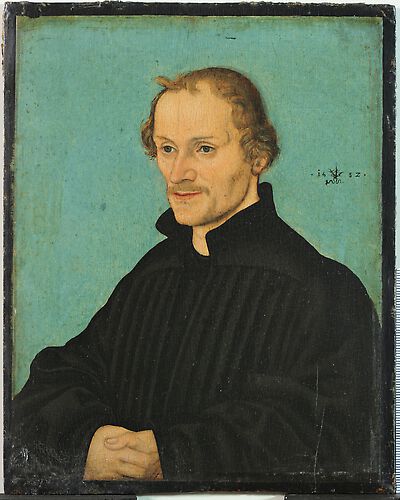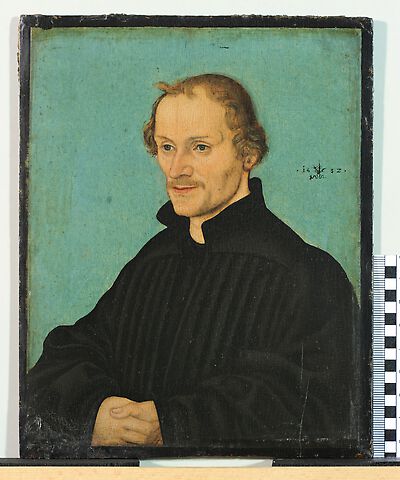[...] Later copies and variants of this pictorial type exist, which vary in format, composition and some details. [1] Whereas pendant pieces depicting Martin Luther have survived for the versions in Berlin, Regensburg and Dresden these are missing for both the painting in Munich and Gotha. However a portrait of the Wittenberg reformer probably originally served as the pendant to each of these paintings. Serial production of the small format portraits of Luther and Melanchthon began in 1532 and remained with regards to the portrait of Luther unaltered. Conversely from 1543 the representation of Melanchthon was modified with a pointed beard and a beret, as illustrated by the small panel in Kassel (see Cat No. 36). [2]
Beyond the possible function as a friendship portrait [3] the serial character of this portrait type allows an association with the current political and confessional developments: the year 1532 marked the accession to power of Johann Friedrich the Magnanimous of Saxony, succeeding his father Johann the Steadfast of Saxony as elector and supporter of the reformation. Prior to this in 1530 the frontiers between the confessional factions had been further aggravated by a Lutheran confessional statement, the ‚Confessio Augustana‘, written under Melanchthon’s guidance and presented to the emperor at the Reichstag in Augsburg. This situation culminated in the formation of the protestant alliance the Schmalkaldic League. [4] The portraits could therefore have served a politically motivated propaganda of the new faith and its representatives, whose ‘image’ was to be embedded in the conscious mind through the serial character of the paintings.[5] On the other hand they can be interpreted as the indirect expression of support from the new elector for the reformist cause, and may have been gifts to like-minded rulers. [6]
By virtue of recent insights acquired regarding specific features of the painting in Gotha the question of a new attribution must be posed: [7] among others the specific rendition of the insignia and the addition of dots to the date links the painting with other portraits of Luther and Melanchthon as well as other thematic works from the Cranach workshop and as such relates it to works firmly attributed to Cranach’s eldest son Hans who died young. [8] Serial portraits like that of Melanchthon may have been used as an exercise for Cranach’s standardized production, while a deviation from the standard signature employed by the Cranach-workshop may have functioned as the mark of an individual assistant. [9]
[1] For an overview see: Friedländer, Rosenberg 1979, 131, Nos. 314 - 315
[2] Exhib. Cat. Kronach 1994, 354, No. 178 and Cat. Kassel 1997, 82-86, Nos. 52, 53
[3] Exhib. Cat. Kronach 1994, 354, No. 178
[4] Exhib. Cat. Chemnitz 2005, 477-479, Fn. 11; Exhib. Cat. Munich 2011, 60f., Nos. 5-7
[5] Hinz 1994, 175, Nos. 34, 35
[6] For a discussion regarding the purpose of such gifts see also the essay by Sebastian Dohe in this publication.
[7] Heydenreich 2015. I would like to thank the author for providing me with the unpublished article.
[8] The above mentioned portraits in Dresden were previously associated with Hans in: Exhib. Cat. Chemnitz 2005, 478.
[9] Heydenreich 2015, 135.
[Julia Carrasco, in Exhib. Cat. Gotha, Kassel 2015, 154]



